You might’ve seen Matter of Fact skincare all over social media lately. Their star product is a vitamin C serum, and they’ve been doing a lot of sponsorships with influencers, particularly the ones that come across as “sciencey” (with a science background and/or make scientific skincare content).
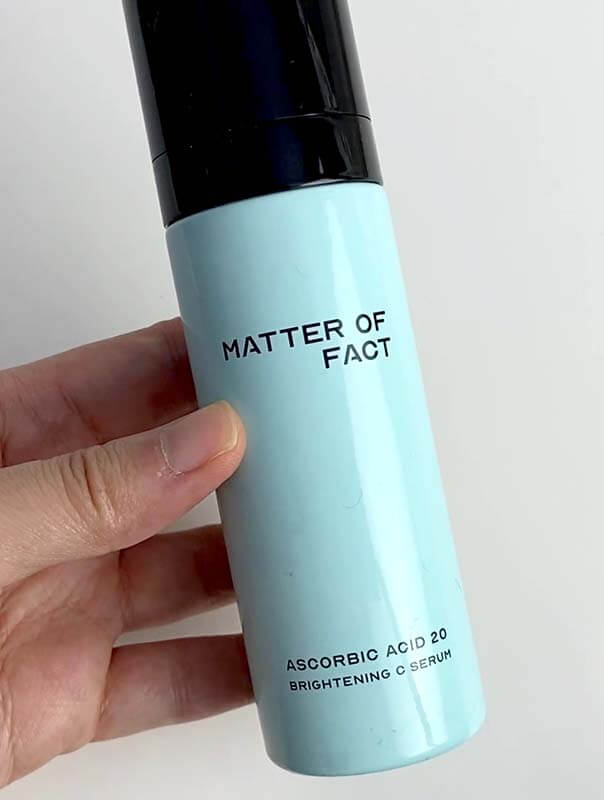
You might’ve been surprised to see me in one of their influencer ads recently.

I was surprised too, because no one asked me, and three months earlier I told their founder exactly why I didn’t want to do a sponsorship with them or endorse them in any way.
So today I’m interrupting our regular viewing schedule to talk about how Matter of Fact annoyed me enough to pause the endless list of content I’m working on to spend literal days on this – the video version, complete with animations and paper dolls is here, keep scrolling if you prefer reading…

Science-washing: “Science” for Profit
Have you noticed that skincare science has gotten really trendy?
For us, as skincare users, it makes sense. We want to use products that actually work, and understanding the science behind how products work is a really good way to go about it. You can find out what does and doesn’t matter, so you can focus on what products make sense for your skin, and your life. And learning science is just kinda fun.
I think skincare science really got trendy with The Ordinary – suddenly we all had a reason to learn these complex ingredient names because each product cost less than $10.
And while that was cool – I really like that we all found each other and got to nerd out about skincare science together – it also meant a lot of brands saw this and started thinking, “Hmm… how do we get in on this?”
Using science to sell products isn’t anything new.
On one level, it makes perfect sense. If a brand has invested time and money into making sure their product works well, then explaining how it works and showing all the testing they’ve done is a great way to show people why they should choose that product.
And if science is trendy, people are more interested in the details, and the brand can show more of the data they normally wouldn’t. (Which is great for me. I’m really nosy.)
But science is hard. You have to study, and do lab classes, and do calculations and understand papers.
Or if you don’t want to do that, you have to hire scientists and they take ages to do things. And you have to pay them the whole time.

So what if we just… got rid of the hard stuff?

And that’s where science-washing comes in.
Science-washing is where you take the aesthetic of science and make things look scientific, without actually doing the science part. Things like:
- Talking about studies that aren’t interpreted correctly
- Listing citations that aren’t relevant and hoping no one looks into them
- Using scientific words to try to sound smart, but using them incorrectly
- Using numbers and graphs that don’t make sense
You get the science cred without actually having to deal with the rest of the iceberg. And it makes a lot of sense from a profit perspective – science is expensive.

And here we come to Matter of Fact, who are one of the most science-washed brands I think I’ve ever seen.
All About Matter of Fact
Matter of Fact is a skincare brand that claims to be “moving the science of skincare forward with evidence-based, breakthrough technologies.”
Their star product is vitamin C serum with 20% ascorbic acid that they say is “the most significant advancement in skincare in nearly two decades” with “unmatched stability, potency and cosmetic elegance”.
(This is a big deal because ascorbic acid is an incredible skincare ingredient, but it breaks down very quickly in products.)
Related post: Ultimate Vitamin C Skincare Guide Part 1: Ascorbic Acid (with video)
Their founder is Paul Baek. Their launch email describes him as “A true multi-hyphenate with degrees from Harvard and Wharton” (in psychology and business), and with “a successful K-Pop career on his resume”. He also worked for two years in venture capital, which he doesn’t mention as much.
“…five years in Korean music, two years in business school, two years in venture capital in the early stage startup space…”
Paul Baek, Skincare Anarchy Podcast, 28 Sept 2021
He was also mentored in cosmetic formulation – “specifically, emulsion technology” – by a cosmetic chemist. He says he first got behind a bench in 2018, but in a few short months he’d already made this 20-year breakthrough in chemistry, seemingly without any formal chemistry training, except his mum has a chemistry PhD (that keeps coming up).
“I started getting behind the bench actually in 2018”
Paul Baek, Chemist Confessions IG Live, 25 Feb 2022
“then within … the first few months we had our first breakthrough, and that’s the technology [in the vitamin C serum]”
Paul Baek, Skincare Anarchy Podcast, 28 Sept 2021
He outsmarted all of the thousands of qualified scientists in the cosmetics industry – and his discovery wasn’t even in emulsions, the thing he was mentored in.
Amazing! I guess that’s why his press release says he has “a rare yet brilliant mind for both science and art”.
“Unmatched stability”
I first noticed Matter of Fact when I saw the hype around their launch in September 2021. Their ads made some really bold claims about their Ascorbic Acid 20 serum: it has “unmatched stability in the vitamin C space”, the ascorbic acid was “fully stabilised”.


Since I’m a massive vitamin C nerd, I was really curious.
Here’s their graph showing the stability of their formula versus
“the current gold standard with regard to stability”:

So the obvious question is: what product are they comparing with?
Well, it seems like it has to be Skinceuticals CE Ferulic, since it’s the only vitamin C product anyone calls the “gold standard”. But it isn’t the gold standard for stability. It’s the gold standard for effectiveness on skin.
C E Ferulic is water-based. Water-based vitamin C serums have a serious disadvantage when it comes to stability: ascorbic acid decomposes faster in water. Matter of Fact actually mention this quite a lot:
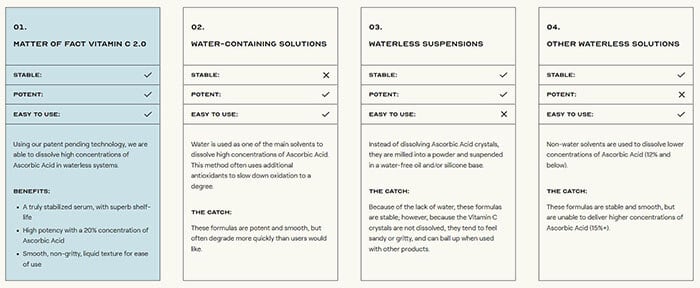

So they’re comparing their waterless vitamin C serum to a water-based vitamin C serum, which is a different, less stable category of product.
It’s like saying Ronnie Baker beat the gold standard Caeleb Dressel, so he’s unmatched in the 100 metres… and then you realise Ronnie Baker is a sprinter and Caeleb Dressel is a swimmer. Caeleb and the water based formula are both fighting against extra water. (I’m pretty proud of that analogy.)
So this is really not good evidence for showing that your product is more stable than every other product “in the vitamin C space”.
I mildly pestered them about what data they had for their “unmatched stability” claim. Paul eventually replied to my email 6 weeks later.
We had a two hour meeting where we talked about the brand and the studies they’d done. He confirmed the other serum in the graph is water-based, and that they tested their product against 3 products in total: 2 water-based and 1 water-free.
I don’t think you need to know much science to recognise that you can’t test against only three products, and conclude that your product is the best out of the thousands of products out there. Especially when you’ve only tested against one other water-free product, and you don’t know how long those products have been sitting on the shelf decomposing and turning into substances that can make it break down faster.
And based on the science, you wouldn’t really expect Matter of Fact’s serum to be the most stable. For example, there are silicone-based vitamin C products like The Ordinary’s Vitamin C Suspensions. A lot of these use the raw material Granactive AA20 which claims to be 90% stable after 3 months at 40 °C at 75% humidity… in an open container.
To me, as a chemist, it seems incredibly unlikely that Matter of Fact’s Serum, with ascorbic acid dissolved in propanediol, can compete with that.

First off, there’s the propanediol base. Propanediol is a humectant moisturiser that’s great at absorbing water from the air (hygroscopic). So if you put it in an open container with any amount of humidity, it’s going to absorb water from the air. That means even if you started off with pure propanediol and no water, you’ll end up with propanediol and water. That water will make the ascorbic acid decompose faster. The propanediol is basically moisturising the ascorbic acid.
Silicone is the opposite. It can potentially form a waterproof layer around the ascorbic acid, which protects it from water. It’s an occlusive, and in this case it’s sealing the water out.
Secondly, Matter of Fact’s serum has dissolved ascorbic acid. When ascorbic acid is dissolved, it can move around a lot more, which means a lot more will be available to react compared to when it’s in solid grains in a thick suspension.
So it doesn’t really make a lot of sense to say this serum has “unmatched stability in the vitamin C space” unless you have a lot of very convincing evidence to back you up. All of the science we know about these ingredients so far goes against the claim, so you’re going to want to have very strong evidence to overturn that. Testing against just one water-free product isn’t going to cut it.
We also talked about the rest of their marketing…

“Science” As Aesthetic
There’s a lot of incorrect science in their social media posts – I think this really reflects a lack of basic scientific understanding, or just that they don’t care enough to fact-check.
The Erythrulose Saga
For example, there’s this post about why vitamin C serums turn brown as they oxidise:

I explained how this wasn’t correct in my Instagram stories. Erythrulose isn’t reddish-brown. For a molecule to be strongly coloured, it needs to have something in its structure that can absorb specific colours of light. Erythrulose’s structure doesn’t have that. (This is something we teach in high school chemistry.)

About a week after this, Paul appeared in a live Q&A session where he showed that ingredient manufacturer specification sheets say 75-80% erythrulose is yellow to orange in colour.
Again, I feel like this is pretty basic. If I have a cup of water that’s not pure water and it’s strongly coloured, it’s not the colourless water making it coloured, it’s something else in there.
When they “fixed” the post, they tried to claim that erythrulose was still “contributing to the colour change”:

But erythrulose isn’t anywhere near intense enough in colour to be making any meaningful contribution to the colour. It looks like this:
In an oxidised vitamin C serum, you have a maximum of maybe 5% erythrulose, which looks like this:

Whereas this is the intensity of colour in an oxidised vitamin C serum:

I also love that they mentioned “the confusion”, as if they weren’t the ones who were confused…
The post also mentions a “3 step process” for the breakdown of ascorbic acid.
“At the end of a 3-step process, [ascorbic acid] eventually degrades into erythrulose…”
Matter of Fact Instagram Post, 2 November 2021
Paul’s mentioned in an interview as well:
“[Ascorbic acid is] a very fragile molecule that’s very prone to degradation… it breaks down into erythrulose in this, you know, sort of three-step process and it degrades in a very visible way too – so going from, you know, white or clear if it’s solubilised, if it’s dissolved in some sort of medium to, you know, turning orange and then brown”
Paul Baek, Skincare Anarchy Podcast, 28 Sept 2021
However, ascorbic acid decomposes via way more than three steps, and it turns into lots of different chemicals, not just erythrulose.
I think this might be because he misinterpreted one of my blog posts. Back in 2017, a lot of people were asking me why vitamin C stains your fingers, and there was concern it was pigment or something harmful. I noticed a diagram in a paper, that showed ascorbic acid decomposing into a bunch of different things including erythrulose, a common fake tan ingredient:

This makes a lot of sense since vitamin C stains look and act a lot like fake tan, so I figured it was probably the erythrulose (or similar chemicals) causing it.
So I wrote a blog post and redrew just the three steps from ascorbic acid to erythrulose to make it clearer, because the diagram above is just too much for the average person who just wants to know why their fingers are yellow, dammit.

I linked the (open access) paper, and I added a paragraph to try to clarify that erythrulose wasn’t the only product – ascorbic acid actually breaks down into tons of different products, and there are more than three steps involved.
But I think Paul didn’t properly understand it and thought what I drew was everything that happened, because it turned into… that.
Meeting Matter of Fact
So after this, I had my meeting with Paul. He said he’s a big fan of my work, mentioning specific blog posts he liked and even my Reddit username. I joked that I should invoice him for the free advice. He said he did want to pay me for some sponsored posts, and discuss hiring me to work for Matter of Fact – to help them design experiments to test their products and check the claims in their marketing.
This last part was pretty sus to me. I’ve been making science content for a long time. I think I’m great at communicating skincare science, but I’m not a regulatory or cosmetic claims expert beyond what I did in my diploma and the regulatory certificate I’m studying (well, meant to be studying anyway). There are scientists who’ve been working in the industry for decades whose job this is – why would you hire a skincare science influencer without the right expertise for this?
His reason was that regulatory and claims people weren’t good at communicating, and he wanted someone who could communicate well.
But then you should hire multiple people. Scientists are specialised for a reason. You can’t hire a biologist to do chemistry, and you can’t hire a science communicator and expect them to deal with all of this very industry-specific stuff accurately.
And if you are genuinely dedicated to empowering people with scientific information, why would you only start hiring people to check the science 3 months after launching?
Matter of Fact have $10 million in investor funding. They can afford to do all of these big influencer sponsorships. They should have plenty of room in their budget to pay a random chemist a couple hundred a month to quickly check their Instagram posts before going live.
For a brand that claims they’re “dedicated to help you cut through the noise” and “demystify skincare science”, this just seemed to me like really messed up priorities.
So this was a big red flag.
I suggested that maybe I could help them with their science communication, but not in a public facing way – they could pay me a rate much lower than my sponsored post rate to fact-check their posts before they went up. Then maybe later down the line, I could do public sponsored content once their content was something I was more comfortable with.
But he wasn’t interested in investing in that. This seemed to me like a pretty big indication that Matter of Fact just wanted to use me and my reputation to make themselves look “scientific”, rather than actually being scientific and putting out accurate information. They seem to want the veneer of credibility without doing any of the hard work to earn it.

So I told Paul if he wanted Matter of Fact to be a “scientific” brand that I’d feel comfortable endorsing, they should fix three things:
Firstly, fix their stability claims, because they didn’t have the data to make those claims.
Secondly, actually fact check their posts properly before posting, so no more of this erythrulose kind of thing. If you want to educate but you’re not sure about something, just don’t post rather than misinforming people just for the sake of engagement and gaining followers.
Thirdly, stop making drug claims in their sponsored posts. Drug claims are when a brand claims their product treats a disease, or changes the structure or function of skin rather than just the appearance. Drug claims shouldn’t be made for cosmetic products like Matter of Fact’s Ascorbic Acid 20 Brightening C Serum.
Drug claims include reducing pigment, reducing wrinkles, promoting collagen production and treating melasma. It also includes referencing studies where active ingredient in your products were found to do these drug things, like in this post:

I know it seems like it should be fine to “state facts”, but there are regulations around this because drugs go through rigorous testing to make sure they work. Single small studies aren’t enough to back up strong drug claims.
Related post: Sneaky Marketing? The Inkey List Succinic Acid Acne Treatment
This is the sort of thing that happens with illegal drug claims:

A lot of skincare brands do make some degree of drug claims, but if you’re a brand that claims to be scientific and ethical and “moving skincare forward”, I think you need to be on top of this. You especially shouldn’t be making the stronger drug claims that the vast majority of brands know not to make, like treating disease and comparing your active ingredient’s effectiveness to a prescription drug (foreshadowing).
For sponsored posts, brands pay influencers to talk about their product. Influencers generally don’t know the difference between drug and cosmetic claims, and brands have to approve the sponsored content before it goes live, so I really think it’s the brand’s responsibility to hire a regulatory consultant to check that all the claims they’re making are above board.
A lot of brands seem to think that if the influencer makes the drug claims in sponsored content and not them it’s not their fault. But no, it’s not a loophole – it still counts as the brand’s marketing claims, just like a regular ad, and both the brand and the influencer are at fault (this is in the FTC guidelines).

Paul agreed that these would be good changes to make, I agreed to have another meeting in the future to discuss working with them again. I go off on my merry way feeling… OK about giving free advice for two hours, but they did seem to want to do better, and hopefully this would improve the state of misinformation in skincare.
A couple of months later, I go back and check what happened.
For point 1, the “unmatched stability” claims are still up.
For point 2, not making easily avoided mistakes – Matter of Fact have used a reference in a post, because citing things make you look credible and sciencey. But they don’t seem to understand how references work, and it kind of looks like they’ve never seen a reference before in their life. Or perhaps they really felt strongly about Leslie doing three people’s worth of work:

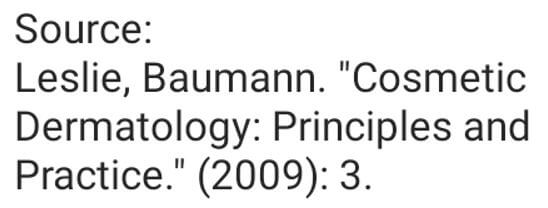
And then after I posted a story about that, they tried to fix it again and somehow managed to double up the title. As of posting, it still looks like this.

More egregiously, they’ve included the molecular structure of retinol in a post because chemical structures are Science, I guess. But they chopped off half the retinol molecule, which makes it a completely different chemical.

They actually managed to get rid of the bit that makes it retinOL, so I guess this is reti?

Hot tip for brands: If you’re going to use chemical structures to science up your brand’s marketing, the bare minimum you should do is a three second Google for the structure.

And then instead of owning up to the mistake, they dug deeper and said:
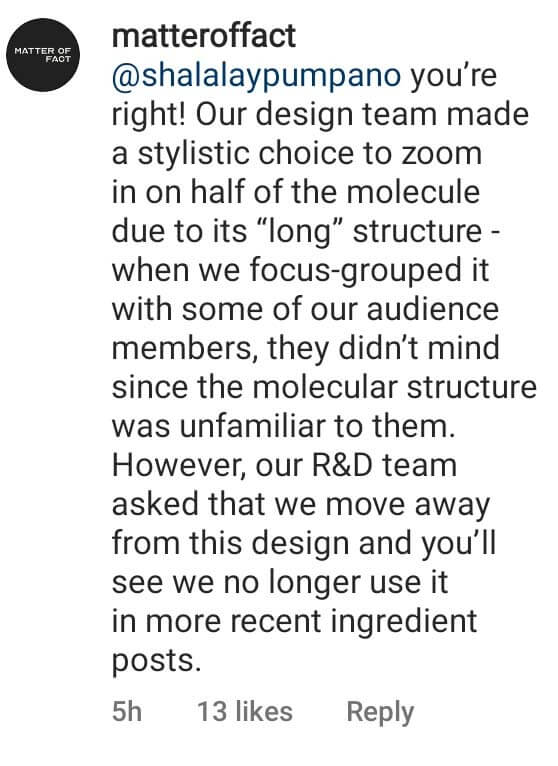
I feel like this should go without saying, but you can’t change the way chemical structures work just because you “focus-grouped it”. The structure is the molecule. This isn’t retinol anymore.
It’s like labelling this as Africa because your focus group said it was fine:

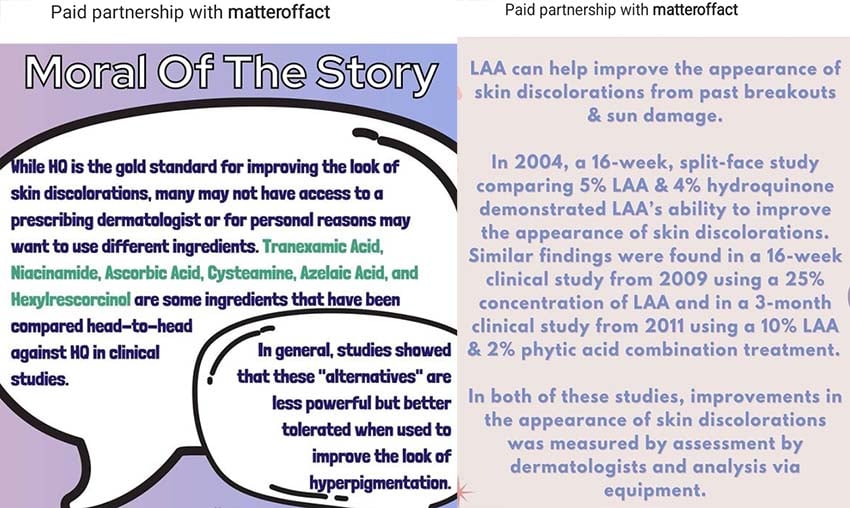
So I wrote an email to Paul on January 26th about these issues. I still haven’t gotten a reply, even though they clearly saw it.
A Matter of Fact Ad, Starring Me
And then on March 13, I get tagged in a sponsored post that an influencer made for Matter of Fact, saying they advocate for women in science like me for Women’s History Month, and to buy their products for the women in your life.


On the face of it, this is kind of a nice shoutout from the influencer, who didn’t know all of this going on behind the scenes (although it’s a bit weird / against advertising codes to put someone in a sponsored post you’re being paid for without asking them first).
But for influencer sponsorships, the influencer sends the final draft to the brand, and they sign off on it before it goes live. So Matter of Fact would’ve seen me in the draft post and approved this, after all these interactions with them, and still without replying to my email about poor amputated Reti after 40 days – not to mention without checking if they could legally use someone in an ad without their consent.
And even though this isn’t an ad specifically for their products, it’s still an ad. Lots of companies do ads where they talk about their values so you can feel good about them and buy their products. And I don’t know why Matter of Fact thought I’d be comfortable being used to improve their public image after all of this.
Obviously I complained about this, and they eventually took it down after about 2 days – again without any sort of communication with me or any sort of apology. I had to ask the influencer to contact Matter of Fact. Matter of Fact also blocked my comments from showing up on their posts, which I think is amazing advocacy for me.
“Breakthrough Discovery”?
I guess the extremely obvious question we’re building up to is: how did someone who gets so much basic chemistry wrong discover such a “breakthrough”, “unique”, “first of their kind” formulation?
How did Paul Baek, whose only chemistry background is essentially his mum and his “rare and brilliant mind”, outsmart all of the qualified chemists in the cosmetics industry, “crack the elusive code” and create “the most significant advancement in skincare in nearly two decades”, after just a few months in the lab?
Well, if you look at Matter of Fact’s vitamin C patent (as of now still pending), it seems like he… kinda didn’t.
This is the “breakthrough” that Paul claims to have made:
“It just boiled down to: is there a way to dissolve high concentrations of ascorbic acid in solvents that are not water? That’s sort of where I started … and through a lot of experimentation, found a way to do it…”
Paul Baek, Chemist Confessions IG Live, 25 Feb 2022
“The eureka moment was thinking about other ingredients that were not liquid at room temperature potentially being co-solvents, and using that framework allowed us to sort of create this this new technology…”
Paul Baek, Meet Our Founder, 27 Oct 2021
In short, he’s saying he’s worked out a way to get more ascorbic acid to dissolve without water.
You can only get about 12% ascorbic acid to dissolve in propanediol. But if you add urea, you can get over 20% to dissolve. So that’s what the Matter of Fact serum does – it seems to contain 20% ascorbic acid and 10% urea in propandiol.
This sounds really neat, but someone else already discovered this… 17 years ago.


And it isn’t like Matter of Fact aren’t aware of this. They reference them extensively in their own patent application:

Even without much science or chemistry knowledge, I think it’s pretty obvious that this 2007 patent is about using urea to help ascorbic acid dissolve in polyol.
Apart from this – which someone else discovered first – I can’t really see what’s so “innovative” or “breakthrough” about this formula.

It has other antioxidants – ferulic acid and a plant extract (and the diglycerin solvent that the plant extract comes with) – but every other vitamin C serum on the market has other antioxidants. The 2007 patent application also covers formulas with antioxidants.
Maybe the fact it’s stable? But testing someone else’s discovery doesn’t mean you discovered it.
It looks like Paul might’ve seen what he thought was a potential loophole and tried to file a patent for that. The two 2007 Zhang patents listed examples of polyol solvents that were covered, but one of the patents didn’t explicitly list 1,3-propanediol, which is used in the Matter of Fact serum.

The Matter of Fact patent singles out 1,3-propanediol specifically several times in their claims:

I’m guessing Zhang might’ve left propanediol out because it wasn’t a common skincare ingredient back then, or maybe he just forgot, because he did list it as an example in the other 2007 patent, and it’s covered under polyols anyway.
Here’s all the polyols Zhang listed explicitly in his patent claim, along with 1,3-propanediol.

Can you pick out the distinctly innovative, groundbreaking one that supposedly counts as the most significant advancement in skincare in two decades? I wouldn’t be able to. (It’s the top right structure, by the way.)
I’m not a patent attorney so I don’t know if this patent will get past “pending” – the rule is that patents need to be novel, and not a trivial or routine advancement on an existing patent. If it’s very similar to an older patent, they often decide it’s covered by the original.
If this is indeed what Paul’s claiming to have discovered – what’s essentially a typo, and I would think it’s covered under the old patent anyway – legality aside, this just doesn’t seem like that much of a “Eureka moment” to me.
1,2-Propanediol (propylene glycol), 1,3-propanediol (propanediol) and 1,3-butanediol (butylene glycol) are incredibly similar chemicals, as you can guess from the names, and they’re used interchangeably in skincare.

It really doesn’t seem to me that this is “a truly new technology”, or that Paul actually created it. Biggest breakthrough in 2 decades seems like a pretty big stretch.
Unmatched stability?
So at the end of all this, is Matter of Fact’s formula “fully stabilised” with “unmatched stability”?
Well, I don’t think so.
I was sent some bottles in December 2021. They expire in August 2023 so I’m guessing they were made in August 2021. They’ve already started going a lot yellower than when I first got them. I talked to someone else who was sent the products around the same time, and theirs is actually even more yellow.

You can see how colourless they’re meant to be in their promo photos:

Compared to these other products I’ve had for years – well, you can see the difference in colour.
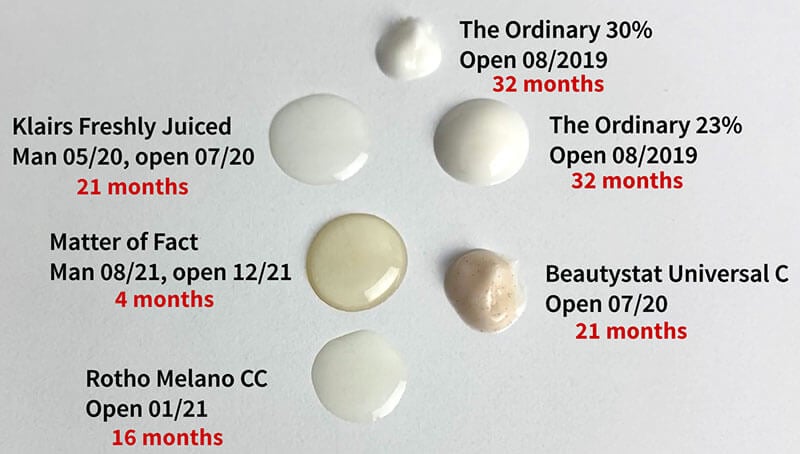
I think it’s because maybe they didn’t test the product properly under real life conditions. All the data they show for their stability claims are with accelerated testing, where they kept the product for 8 weeks at 40 °C to approximate what would happen for 16 months at room temperature (20 °C).

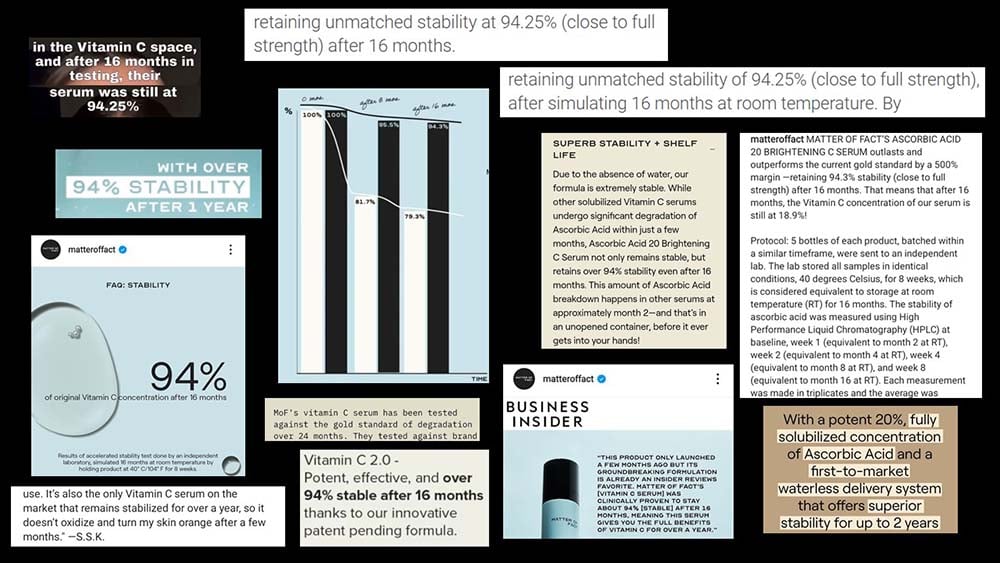
Things react faster at higher temperatures, so accelerated testing is used to get an idea of whether anything is likely to go wrong with the product, without having to wait as long.
But it’s still an approximation. Things happen at 20 °C that don’t happen at 40 °C and vice versa all the time. And this is particularly the case with ascorbic acid. Its degradation is very temperature-dependent, so accelerated testing gives more inaccurate predictions than normal. You really can’t say they’re equivalent.

But Matter of Fact don’t seem to know (or maybe they don’t care) about this pretty important caveat. They hardly ever mention it’s approximate – they keep just saying it’s been tested for 16 months.

I think the packaging is another big issue. Heat doesn’t speed up how quickly oxygen and water leaks into packaging the same way it speeds up chemical reactions.
This is in an airless pump, but most airless pumps aren’t properly airtight. In a standard airless pump – which is what this looks like – oxygen and water can get in through the seams and through the pump dispenser. And given how easily the pump top came off when I opened the tube a few days ago, I’m not really convinced this connection is tight enough to keep propanediol free from water and oxygen.

And before anyone says I’m being unfair because I made it oxidise by opening it up, the serum in the photos is from the mini tube that I don’t know how to open, and it’s the same colour as the other tubes I have.
So these claims of 16 month, 24 month stability aren’t really backed up by their testing.
Again, I want to make it clear I don’t blame the influencers doing sponsored posts for sharing Matter of Fact’s data. These are things about vitamin C I didn’t know 5 years ago, even with a chemistry PhD, even though I was so deep in skincare science. I know cosmetic chemists who’ve worked in the industry for decades who don’t know this stuff because they haven’t specifically worked with vitamin C.
This is why specific expertise exists. There’s just way too much information in this world to know everything. At some point you have to trust what experts say, you have to trust that people who present themselves as experts are responsible and self-aware enough to say when they don’t know something, to check with someone who knows more.
Matter of Fact and Paul gave them this information and checked their posts before they went up – they’re supposed to know what they’re doing. He’s the guy who made the biggest breakthrough in skincare science in two decades. They’re the brand moving the science of skincare forward and empowering consumers with information.
And this is the fundamental issue with sciencewashing. People and brands who pretend to have expertise, but continually put out misinformation because they want to save time or money or look smart – they make it so much harder for consumers to know who to trust and which products to use.
I love talking about skincare science. I love that so many more people care about it now, I love that we have a beauty science nerd community, I love that I’ve met a lot of experts and science communicators through this.
But I can’t deny that there was a lot less misinformation, and it was a lot easier to spot misinformation, before everyone decided they needed to “science things up”.
Julian from MoF accuses me of “bullying”
Update (14/9/2022): Dr Julian Sass (@scamander14 on Instagram), a biostatistician and full-time employee of Matter of Fact (Director of R&D and Education) has publicly accused me of bullying him in a video on his Instagram and Twitter. My response is here.
Relevant to this post and Matter of Fact:
- Interestingly he didn’t mention his association with Matter of Fact anywhere in the video or caption, or when defending Matter of Fact in his Instagram stories after this post went live (his employment contract was signed early March, although he didn’t start until July). (Note: My understanding has always been that Paul intended to hire both of us, so there wasn’t any competition.)
- He was one of the influencers paid by Matter of Fact to compare ascorbic acid to hydroquinone (his post is on the left). As explained below, this would likely be an illegal drug claim. A few weeks before the post went live, I had privately explained to him that a similar claim (niacinamide vs hydroquinone) would be a drug claim, and that claims in sponsored posts counted as the brand’s claims, to which he expressed annoyance. From private conversations and his Twitter announcement of his role (that also didn’t mention Matter of Fact), it seems that his job includes… checking social media posts for illegal claims.
- Some of the criticisms he’s interpreted as “bullying” are to do with the accuracy of his posts, particularly on the mechanisms of how ingredients work (not in his area of expertise) and the strength of the clinical evidence on ingredients (which should be in his area of expertise).
- In his video he seems to have confused “organic” with “inorganic”, and thought zinc oxide and titanium dioxide contain hydrogen… or just didn’t care enough to read the passages before citing them (but at least the references are formatted correctly this time!). Neither option is very reassuring.
- Additionally, Matter of Fact’s social media “science education” is still questionable – for example, saying asiaticoside is also known as “purified centella asiatica extract”, and glycyrrhetinic acid “purified extract of licorice root”. This makes as much chemical sense as calling gold “purified mud”.
- I think these points further speak to Matter of Fact’s bastardisation of science for profit, muddy ethics, and continued insistence on hiring for appearances, rather than appropriate qualifications and experience.



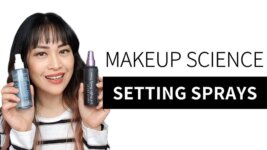


Fantastic video! I’m glad you took the time to make it ❤️❤️
Great post! I’ll be avoiding all Matter of Fact products like the plague. Thanks for going to all the trouble to provide this info.
This post gave me the same kind of thrill I get when an obvious liar/criminal gets caught in a lie and keeps on digging that hole. Thanks for exposing this company and I hope he doesn’t get his patent.
Wow. I needed that read, Michelle!! I had no idea that was going on. Surprisingly haven’t heard of the brand but will look forward to see how and if they repair their claims.
Many years ago, I worked for Neutrogena. This was when it was a family-owned company (it was bought by Johnson and Johnson some time ago). I was the purchasing agent that sourced coconut oil, sesame oil, and several unpronounceable chemicals that made their famous soap, well, famous. I worked closely with the staff scientists to ensure what I sourced/purchased met their exacting standards. Testing took all sorts of long-term forms. One day, I noticed a row of shampoo bottles lined up on a south-facing windowsill. They looked a lot like the products living in my own bathroom window. BINGO! This was a 12-month study of the effects of sunlight on products. It’s true, there is not much that happens quickly. After J&J bought the brand, I noticed ingredient changes and a lot more advertising hype. I’m cautious about investing in beauty brands that make science-y claims.
It is clear you wanted the job. They did not want you. And now you are having your revenge! Sad really!
If I wanted the job, why did I tell him I wasn’t qualified and he should be hiring someone appropriately qualified with far more experience, as mentioned in the post?
Also why did you feel so passionately about this that you needed to comment three times under three different names? Do you work for Matter of Fact by any chance? Or are you one of the influencers who did a sponsored post for them?
omg ilysm <3
Also, I suuuuuper hope Jerry Zhang is still around and sues the pants off of Elizabeth Holmes — oh sorry, I meant Paul Baek — for patent infringement.
Why would “Christine” think that bullying is good PR?! Love this blog, Michelle, keep up the good work and greetings from Seattle 🙂
What’s sad is how the business is making false claims about their products yet here you are trying to come for Michelle who’s a consumers advocate and actively clearing up the insane amount of BS in the beauty market. What were you hoping to achieve from these comments? Do you prefer big businesses to continue misleading consumers with false claims?
It’s clear you want attention and work for a company that has a moral compass. Sad really!
Amazing post, thank you so much! Expertise is becoming under-appreciated more and more, which is very concerning.
Epic!
WHEW! That was interesting…I won’t fall for Matter of Fact claims! Thank you!
Thank you so much for this post! Companies (people) who don’t do their research just contribute to all the misinformation all in the name of making a buck. I appreciate your intelligence/expertise and willingness to go deep to call it like it is. Keep it up!
So pleased we have you in the beauty world! 🌺
Former US patent examiner w/ 8 years experience here ✋(mechanical, not chemical). In my unofficial opinion, you’ve written a sufficient rejection for their patent application and the examiner on the case should thank you 😂. I always appreciated when the applicants would directly cite all of the references needed to reject the application. For an actual patent grant, they would need to be able to pull something novel and non-obvious out of their specification and put it in the claims. Doesn’t seem to me like that is likely to exist in Matter of Fact’s application.
“The propanediol is basically moisturising the ascorbic acid.” Lol!! 🙂 🙂 🙂 #ChemistryJokes
Thank you!!! Can you do a deep dive into Indeed Laboratories?? I’d love to hear if they are what they say they are. As the price is right and Canadaian.
I admit I hadn’t heard of that brand, but they go directly on the list of brands I won’t use or purchase. The miscommunication on it’s own is bad, the way they approved using you in a sponsored post after you making it clear you wouldn’t want to work with them is much worse though.
You put more science and work in to this post than they put in to a whole $10,000,000 company
Im glad I read it
100% this
Thank you for all that you do and being so detailed. I appreciate someone who understands the science to explain the ins and outs of products.
You always produce such information packed, well researched and valuable content. I’m sorry you have to experience the reactions from people affiliated with the brand, but I guess it will show who your real friends are. Doesnt always make it easier, but please do not let them deter you from debunking marketing claims and helping so many people learn and see through the claims.
This was an amazing post, and really delightful constructive criticism. I thought your delivery was direct, very informative, and fair. If MoF wants to improve I hope they do take your criticism to heart.
Absolutely fascinating. I’d seen a few of their ads, but my skin is not in a place where I can experiment with new brands, so I haven’t bought anything. Will be avoiding the brand in the future if they’re going to be the sort of people to hire others to bully you. A lack of knowledge is fixable, but deliberate maliciousness is not acceptable under any circumstances.
Man what a ride! I was so delayed in reading this, but glad I did. It’s brand moves like these that make me super nervous to trust what I’m buying. And I’m not a chemist or expert in any way, so I completely rely on good people like yourself to lay down the know-how. Thanks for posting this! And thanks for all the work you put into these posts and your content in general. It can’t be easy.
Thanks to all of the knowledge you’ve given me over the years, I would have been suspicious of this brand’s claims and done my own research before purchasing. I trust your expertise and data and appreciate your humor that goes along with it!😃♥️
I haven’t seen or heard anything about this brand before, which is fine since I won’t be including it into my skincare routine.
Thank you for this post. People need to know when they are being duped. I can’t speak for the rest of the skincare enthusiast community but I appreciate the work that you do!
This post really just needs to go to the FTC as a prime example of all the ways that a company can make claims and negatively influence user’s feedback (blocking your posts on their website is against FTC regulation).
I have to admit that I was just randomly wandering around the web looking for information on sunscreens when I came across your site. While I only have a BS in Chemistry, I find any excuse to get my nerd on over most any type of Chemistry and I will be bookmarking this site for future nerd partying
Amen! Thank you, Michelle, for being an advocate of sound science and ethics in a field where companies often hoodwink consumers. As a skincare enthusiast who has also worked in product development of emulsion consumer products, I wholeheartedly echo your comment that these high temperature accelerated stability studies are approximations and often are used comparatively to assess risks (like color or odor change). They are NOT equivalent to degradation reactions under ambient conditions. I also very much appreciated your humor on poor Reti’s loss and education in the legality bit.
Please continue your great work!
I just came across your channel lately and watched this video, and heard you were harassed by people. I mean, shame on them. Thanks very much for your thorough analysis. That’s lotsssss of work I can tell… If someone is to refute, they’d better be showing as much CORRECT information, instead of attacking you on irrelevant subjects.
Isn’t Accu-Biochem the testing lab that got an FDA warning/notice? For discrepancies.
Thank you for this post! As a biochemist by training, virologist by day and avid skincare enthusiast by night…I LOVE YOUR SITE!!!! Delving deep into an area of expertise that’s aligned with your own is challenging enough, but becomes exponentially harder as the area becomes more tangential. And then to present your findings in laymen’s terms…Kudos! I hope you keep doing what your are doing with joy and passion because your posts have saved me hours if not weeks of researching brands and claims like this on my own (shout out to PubMed, ClinicalTrials.gov, USPTO, WIPO and other science sites).